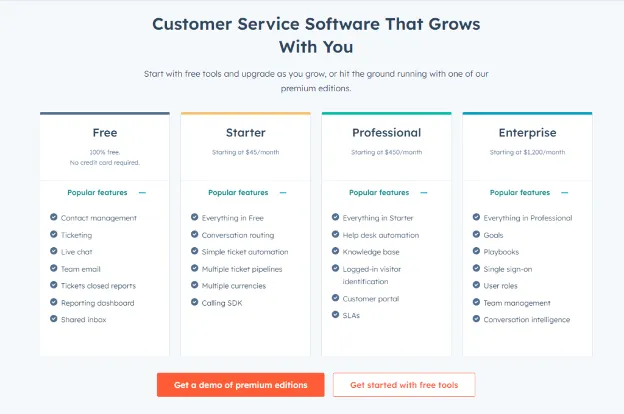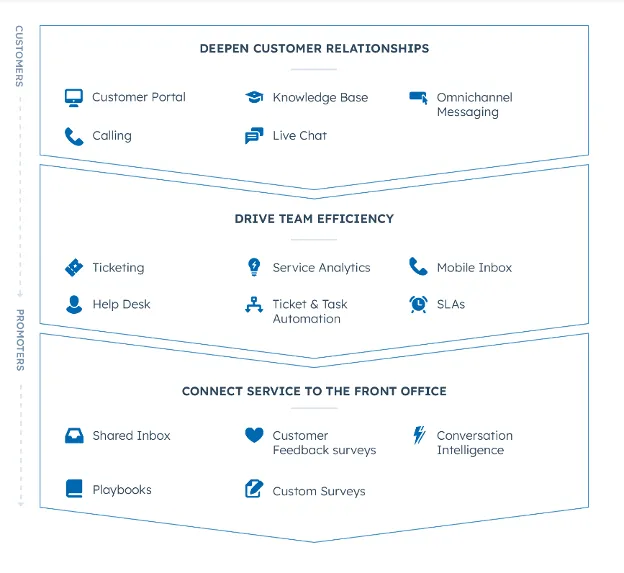Understanding HubSpot Service Hub Pricing: Is It Right for Your Business

-
-
My Journey with HubSpot
-
Why HubSpot Service Hub?
-
The Decision: Investing in HubSpot Service Hub
-
Understanding HubSpot Service Hub Pricing
-
Features across Pricing Tiers
-
Weighing the Cost against the Benefits
-
My Experience with HubSpot Service Hub
-
The Impact of HubSpot Service Hub on Our Business
-
Is HubSpot Service Hub Worth the Investment?
-
Conclusion
Disclosure: Some of the links in this article may be affiliate links, which can provide compensation to me at no cost to you if you decide to purchase. This site is not intended to provide financial advice and is for entertainment only.
In the world of customer service, one name stands out: HubSpot Service Hub. But with varying pricing tiers, is this customer service software the right fit for your business? In this post, we delve into a comprehensive examination of HubSpot Service Hub Pricing.
My Journey with HubSpot
As a business owner, I've always focused on enhancing customer service, a key factor of business success. With an overwhelming number of options, my quest for a solution led me to the HubSpot Service Hub. Renowned for its all-in-one approach to customer service, it stood out in the crowded field. However, I knew better than to dive in without a complete understanding of the product and its pricing. This post aims to not only recount my journey to HubSpot Service Hub but also serve as a guide to other entrepreneurs, providing insights into the process of evaluating its viability, operational impact, and return on investment.
Why HubSpot Service Hub?
The quest for an all-encompassing platform to streamline customer service led me to the HubSpot Service Hub. This robust platform offered a harmonized solution to all facets of customer service management, distinguishing itself in a market replete with customer service software options. A shared inbox for consolidated customer communication, potent knowledge base creation tools for enhanced self-service, automated feedback collection, and analytical dashboards for performance tracking and data-driven decision-making - these were some of the pivotal features that resonated with our business needs.
HubSpot Service Hub wasn't just a ticketing system or a feedback tool; it was a comprehensive solution that promised to elevate our customer service experience. The shared inbox streamlined our responses by unifying all customer communications into a single platform, eliminating the need to juggle between multiple channels. The knowledge base empowered our customers with immediate solutions to common queries, enabling our team to address more complex issues.
The platform's automated customer feedback surveys and reporting dashboards were invaluable resources for our customer service improvement endeavors. They facilitated an understanding of our strengths and areas of improvement and enabled data-driven, performance-oriented decision-making. Despite the allure of these features, I was cognizant that the tool's effectiveness would ultimately depend on its implementation and affordability. This realization spurred an examination of the HubSpot Service Hub's pricing structure to ascertain if it justified the investment.
The Decision: Investing in HubSpot Service Hub
The decision to invest in a new platform for your business, especially one as pivotal as a customer service solution, is not one to take lightly. Among the many factors to consider, pricing undeniably sits at the forefront. For us, the burning question was: "Is the HubSpot Service Hub pricing justifiable for our business?"
However, the answer isn't merely found in the dollar amount. The cost is only one side of the equation. True value, the kind that warrants investment, goes beyond the monetary investment to the benefits it will bring to the business. For HubSpot Service Hub, we needed to examine what it could provide to our company in terms of enhanced customer service, streamlined operations, and potential growth in customer loyalty and satisfaction.
Before we jumped in with both feet, we decided it was essential to dig deep into the intricacies of the HubSpot Service Hub pricing model. This meant understanding the different plans available, the features each offered, and the potential return on investment we could expect. It was not just about finding a plan that fit our current budget, but also a solution that would scale with us as our business grows and our needs evolve.
We understood that the initial cost might seem high, but if the platform could improve our customer service, increase customer retention, and give us a competitive edge, it could very well be an investment worth making. These were the aspects we kept in mind as we delved into the details of the HubSpot Service Hub pricing model.
Understanding HubSpot Service Hub Pricing
HubSpot Service Hub has structured its pricing to cater to different business needs and stages. It operates on a tiered model, offering four main levels of access: Free, Starter, Professional, and Enterprise. Each tier offers a different set of features, allowing you to pick and choose based on what suits your organization the most.
The Free tier offers a taste of HubSpot's capabilities, providing basic functionalities such as ticketing and customer feedback. It is an excellent option for businesses dipping their toes into customer service software for the first time or those with very basic requirements.
Next comes the Starter tier, priced at $18 per month. This level incorporates all features from the Free tier and adds more robust tools such as custom support form fields, live chat, and conversation bots. The Starter tier is ideal for small businesses wanting to step up their customer service without going overboard on expenditure.
The Professional tier, priced at $450 per month, offers a more comprehensive suite of services. It encompasses all Starter features and adds key components like knowledge base, 1:1 video creation, multi-language support, and so much more. This tier is designed for medium-sized businesses with a larger customer base and more complex customer service needs.
The top-tier, Enterprise, comes in at $1,200 per month and is the ultimate package. It includes all the features from the previous tiers and tacks on sophisticated tools like advanced reporting, playbooks, user roles, and a slew of others. The Enterprise tier is geared towards large businesses with high-level needs in customer service management.
Essentially, the difference in cost across the tiers comes down to the depth and breadth of features and tools offered at each level. This structure is designed to give businesses the flexibility to choose what fits their needs and budget. Additionally, as your business grows and your requirements change, HubSpot Service Hub can scale with you, making it a potentially sound long-term investment.
Features across Pricing Tiers
The HubSpot Service Hub offers a range of features across its various pricing tiers. The idea is to meet the diverse needs of businesses at different stages and scales, from startups to large corporations.
Starting with the Free version, you get foundational customer service features like ticketing and email templates. This allows businesses to manage their customer inquiries effectively and efficiently, even on a budget. Even with these basic features, you can begin to see the impact on your customer service experience.
The Starter tier, costing $18 per month, steps up the game by introducing live chat and conversational bots to the mix. Live chat ensures real-time, personalized interactions with customers, while the conversational bots help automate routine queries, saving your team valuable time.
Then comes the Professional tier, priced at $450 per month. Here, you gain access to more sophisticated tools. Not only do you get all the features from the Free and Starter tiers, but you also get a robust knowledge base management system. This enables you to create, organize, and share help articles, reducing the load on your customer service team and empowering your customers to find answers independently. In addition, you also gain access to advanced reporting features that help monitor and measure your customer service performance, ensuring continuous improvement.
The top tier, Enterprise, priced at $1,200 per month, offers the most comprehensive set of features. This tier unlocks automation tools, advanced reporting, and goal setting features, to name a few. The user roles feature allows you to define who can do what within the system, enhancing your control over the operations.
Overall, as you move up the tiers, the feature set becomes increasingly comprehensive, allowing for more sophisticated, streamlined, and efficient customer service operations. However, every tier has its unique value, and the right choice would depend on your specific needs, budget, and growth plans.
Weighing the Cost against the Benefits
When assessing the HubSpot Service Hub pricing, the primary focus should be on striking a balance between the investment you are making and the benefits your business stands to gain from the platform. Given the tiered nature of HubSpot's pricing structure, the options cater to different needs, allowing businesses of various scales and complexities to find a suitable plan.
For budding businesses or startups, the Starter tier, priced at $50 per month, may be the ideal choice. Despite being the second lowest tier, it offers robust features that can give a significant boost to your customer service capabilities. This includes live chat for immediate customer interaction, conversational bots for effective automation, ticketing systems for efficient issue tracking, and even team email for unified communication. It is not just about the affordability of this plan but the value it offers to small businesses that need to build solid customer relations without hefty investments.
Contrastingly, for larger corporations with intricate customer service needs, the Enterprise tier, at $1,200 per month, can be the more apt choice. While the cost is undeniably higher, the range of advanced features it offers justifies the price tag. You get access to sophisticated tools like advanced reporting for deeper insights, knowledge base management for streamlining customer self-service, automation for scaling customer interactions, and goal setting for benchmarking performance. When seen in the light of the comprehensive capabilities it provides to optimize and elevate your customer service, the investment can be seen as worthwhile.
The cost-benefit analysis of HubSpot Service Hub pricing isn't solely about dollars and cents. It's about aligning the platform's capabilities with your business needs and growth plans. It's about how the platform can facilitate your team in providing top-notch customer service, how it can help understand your customers better, and how it can ultimately contribute to your business's success story. Every business has its unique needs, and it's essential to consider these factors while determining if the price you pay for HubSpot Service Hub aligns with the value you seek to derive from it.
My Experience with HubSpot Service Hub
My decision to invest in the Professional tier of HubSpot Service Hub led to a significant transformation in our customer service management. As soon as we began implementing the tools and features provided, the positive changes in our workflow were immediately noticeable.
For starters, the HubSpot Service Hub drastically improved our ability to handle and organize customer queries. With the help of a ticketing system, we could track every customer request, ensuring that no query went unanswered or fell through the cracks. Each ticket was assigned a unique ID that allowed us to monitor its status, helping us keep our response times in check and improving overall customer satisfaction.
Furthermore, the reporting dashboard provided us with crucial insights into our performance. We could track essential metrics, like average response time, resolution time, and customer satisfaction scores. These statistics played a key role in identifying areas of improvement and benchmarking our performance. It offered a clear and concise view of our customer service landscape, helping us make informed decisions and implement effective strategies.
The automation features were also a game-changer. With the help of the built-in automation tools, we were able to automate routine tasks, which freed up our team's time to focus on more complex customer issues. For instance, we created workflows to automatically assign tickets to the appropriate team member based on the type of query. This resulted in a more efficient distribution of tasks and significantly reduced manual intervention.
One of the features that particularly stood out was the knowledge base tool. We were able to compile and organize useful articles, FAQs, and guides, providing our customers with a self-service option. This empowered our customers to find solutions to their issues at their own pace and convenience, further enhancing their experience with us.
All in all, investing in the Professional tier of HubSpot Service Hub brought about an organizational revolution in our customer service operations. It enabled us to handle customer queries more effectively, offered valuable insights into our performance, and helped us provide an enhanced customer experience. It became clear that the HubSpot Service Hub pricing was indeed justified by the value it provided to our business.
The Impact of HubSpot Service Hub on Our Business
The impact of the HubSpot Service Hub on our business operations was palpable within a few months of integrating it into our systems. One of the most compelling outcomes was the noticeable rise in our customer satisfaction ratings. This was a testament to the streamlined customer service and prompt responses we could now offer thanks to HubSpot's advanced ticketing and automated response systems. We received positive feedback from our customers, who appreciated the speed and efficiency with which their queries were addressed.
In addition, the toolset provided by HubSpot played a critical role in dramatically reducing our response times. Earlier, managing and prioritizing a deluge of customer queries was a challenging task. However, with HubSpot's automated ticketing and workflow systems, we could effectively classify and assign issues, ensuring a swift resolution. This, combined with the ease of monitoring each ticket's progress, helped us significantly reduce the time it took to respond to and resolve customer issues.
But the benefits didn't stop at improving our external relations with customers. Internally, we observed a considerable surge in our team's productivity levels. The automation features offloaded much of the manual work that our team had to previously handle. This allowed them to focus their efforts on resolving complex customer queries and improving our service quality. The ability to automate responses for frequently asked questions and routine tasks helped us make better use of our resources.
Additionally, the comprehensive reporting and performance tracking tools helped us measure our team's effectiveness and productivity accurately. We could identify any bottlenecks or areas that needed improvement, leading to informed decision-making and effective strategizing. The insights gleaned from these metrics were instrumental in shaping our customer service policies and refining our workflow processes.
Is HubSpot Service Hub Worth the Investment?
Looking back on our decision to invest in the HubSpot Service Hub, there's no doubt that it was a strategic move that paid dividends. Assessing the return on investment, however, requires a holistic perspective that goes beyond mere financial calculation. The HubSpot Service Hub is more than just a customer service software solution; it's an asset that significantly improves the quality of service you can deliver and, consequently, the customer satisfaction and loyalty you can achieve.
The investment in HubSpot Service Hub has more than justified itself in our experience. The benefits we derived have been multifaceted, touching all aspects of our customer service operations. From bolstering our customer satisfaction levels to streamlining our internal processes, the impacts have been substantial.
Improved customer satisfaction was one of the most immediate and apparent returns on our investment. Higher satisfaction levels not only increased customer loyalty but also boosted our brand's reputation, driving customer referrals and consequently impacting our bottom line positively. Furthermore, it's important to note that acquiring a new customer is often more costly than retaining an existing one, so the increased customer retention rates we observed also contributed to cost savings.
On the operational side, the efficiency gains were also noteworthy. We saw a significant reduction in our response times and an improvement in issue resolution efficiency. Automating routine tasks liberated our customer service team from time-consuming manual work, allowing them to focus on solving more complex customer issues. This operational efficiency not only improved our service quality but also led to substantial time and cost savings.
The advanced analytics and reporting features provided valuable insights into our customer service performance and customer behavior, enabling us to continuously refine our customer service strategy. This data-driven approach to customer service gave us a competitive edge and helped us remain agile and responsive to our customers' needs.
Weighing these benefits against the HubSpot Service Hub pricing, it becomes clear that this investment has been a worthwhile one for our business. But it's not just about the benefits we've experienced. It's also about the potential drawbacks and losses we've avoided – such as losing customers due to poor service or inefficiencies in handling customer queries.
Conclusion
Understanding the HubSpot Service Hub pricing structure is crucial to determining if it's the right fit for your business. For us, it turned out to be an excellent investment. Your decision will ultimately depend on your business size, budget, and customer service needs.
By sharing my journey, I hope to give you a clear perspective on the HubSpot Service Hub pricing and its potential impact on your business. Take the time to assess your needs, weigh the pros and cons, and make an informed decision.
-
-
My Journey with HubSpot
-
Why HubSpot Service Hub?
-
The Decision: Investing in HubSpot Service Hub
-
Understanding HubSpot Service Hub Pricing
-
Features across Pricing Tiers
-
Weighing the Cost against the Benefits
-
My Experience with HubSpot Service Hub
-
The Impact of HubSpot Service Hub on Our Business
-
Is HubSpot Service Hub Worth the Investment?
-
Conclusion
Disclosure: Some of the links in this article may be affiliate links, which can provide compensation to me at no cost to you if you decide to purchase. This site is not intended to provide financial advice and is for entertainment only.









